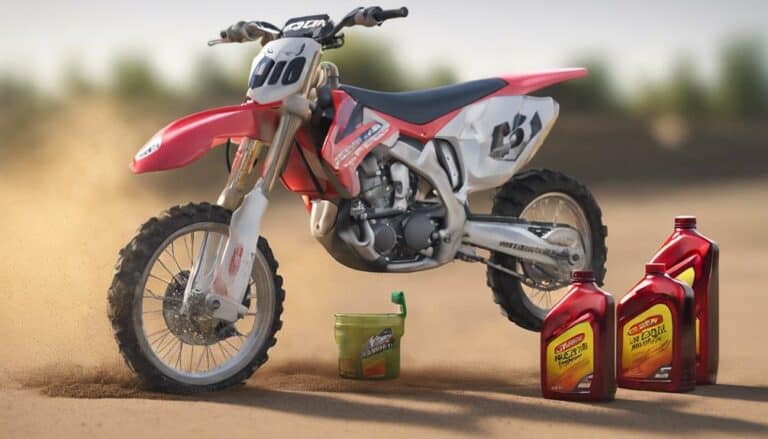Have you ever wondered if it's okay to mix different brands of engine oil in your dirt bike?
While it might seem like a quick fix, the implications of this practice can be more complex than you think.
Mixing oils from various brands can lead to unforeseen consequences that may impact your bike's performance and longevity.
So, before you make a decision on this matter, it's important to weigh the potential risks and benefits carefully.
Key Takeaways
- Mixing different oil brands can disrupt additive packages.
- Compatibility issues and compromised protection may arise.
- Use similar viscosity oils for minimal risk.
- Consistency with one brand is best for engine health.
Pros and Cons of Mixing Brands
What're the advantages and drawbacks of mixing different brands of engine oil in a dirt bike?
When considering the mix of different brands of engine oil in your dirt bike, it's important to weigh the potential impacts on performance. While mixing oils from various brands may not immediately cause harm due to industry standards, it can affect the overall performance and longevity of your engine.
Engine oils are composed of base oils sourced from a limited number of refineries, with additive packages making up a significant portion of the oil's composition. These additive packages can interact in different ways when mixed, potentially altering the oil's properties and how it functions within your engine.
Compatibility of Different Engine Oils
Mixing different brands of engine oils in your dirt bike can lead to compatibility issues due to variations in proprietary additive packages utilized by different manufacturers. Each brand formulates their engine oil with a specific blend of additives to enhance performance and provide adequate engine protection.
When you mix different oils, these carefully balanced additive packages may not work well together, potentially leading to reduced lubrication efficiency or even damaging effects on engine components.
Since additive packages can make up a significant portion of the oil volume, mixing brands can disrupt the proportions of these additives, affecting the overall performance of the oil blend. To assure engine protection, consistency in using the same brand and formula of oil is recommended. This approach helps maintain the intended chemical balance in the oil and reduces the risk of compatibility issues arising from mixing different brands.
Potential Risks of Mixing Brands
When combining different brands of engine oil in your dirt bike, consider the potential risks associated with altering the carefully engineered additive packages.
- Disruption of Additive Package Proportions:
Mixing different brands may disrupt the carefully selected additive package proportions, potentially affecting performance and durability.
- Compatibility Issues:
Different brands may utilize proprietary additive packages, leading to compatibility issues when mixed.
- Compromised Protection:
Mixing brands of engine oil might compromise the intended friction and corrosion protection, impacting best engine health.
- Consistency Recommended:
Consistency in using the same brand and formula of oil is recommended to ensure the best engine protection remains at its best.
Understanding the risks involved in mixing different brands of engine oil is essential to maintaining the performance and longevity of your dirt bike. To avoid potential complications, sticking to a single brand and formula is advisable. Always prioritize the health of your engine by being mindful of the compatibility of engine oils to prevent any unwanted issues.
Best Practices for Using Multiple Brands
Considering the potential impacts on performance and durability, understanding the best practices for using multiple brands of engine oil in your dirt bike is essential for maintaining top engine health.
When you blend different brands of engine oil, make sure that you use a different brand with a similar viscosity and service grade to maintain consistent performance. Recognize that blending oils can affect the additive packages, which make up to 25% of the oil's volume, potentially impacting your engine's performance.
To guarantee peak engine protection, it's recommended to stick to the same brand and formula of oil. Be aware that blending oils may compromise oil performance, leading to the need for an earlier oil change to safeguard your engine's health.
Expert Recommendations on Mixing Oils
For perfect engine performance and longevity, expert advice suggests sticking to the same brand and formula of engine oil when blending different oils in your dirt bike. When considering mixing oils, remember these expert recommendations:
- Mix Brands Carefully: If you must blend different brands, make sure they're compatible to minimize any potential negative effects on your engine.
- Stick to Full Synthetic: Full synthetic oils generally have more consistent properties, making them a better choice for blending compared to mineral oils.
- Consider an Early Oil Change: After blending oils, it's advisable to change the oil sooner rather than later to maintain ideal engine health.
- Prioritize Consistency: Consistently using the same brand and formula of oil will provide the best protection for your dirt bike's engine over time.
Conclusion
To sum up, while mixing different brands of engine oil in your dirt bike may be acceptable in certain situations, it's important to contemplate the potential impact on performance and durability.
Just like blending colors on a canvas, the combination of oils can create a unique blend that may affect engine health.
By following best practices and expert recommendations, you can guarantee smooth operation and longevity for your dirt bike's engine.

